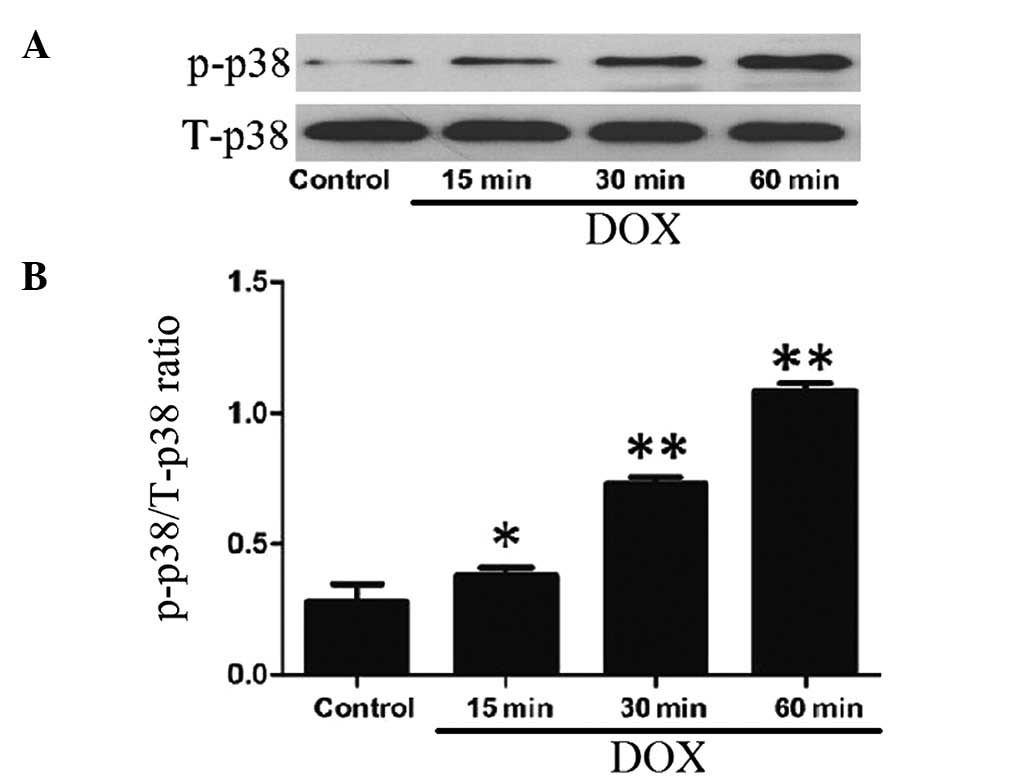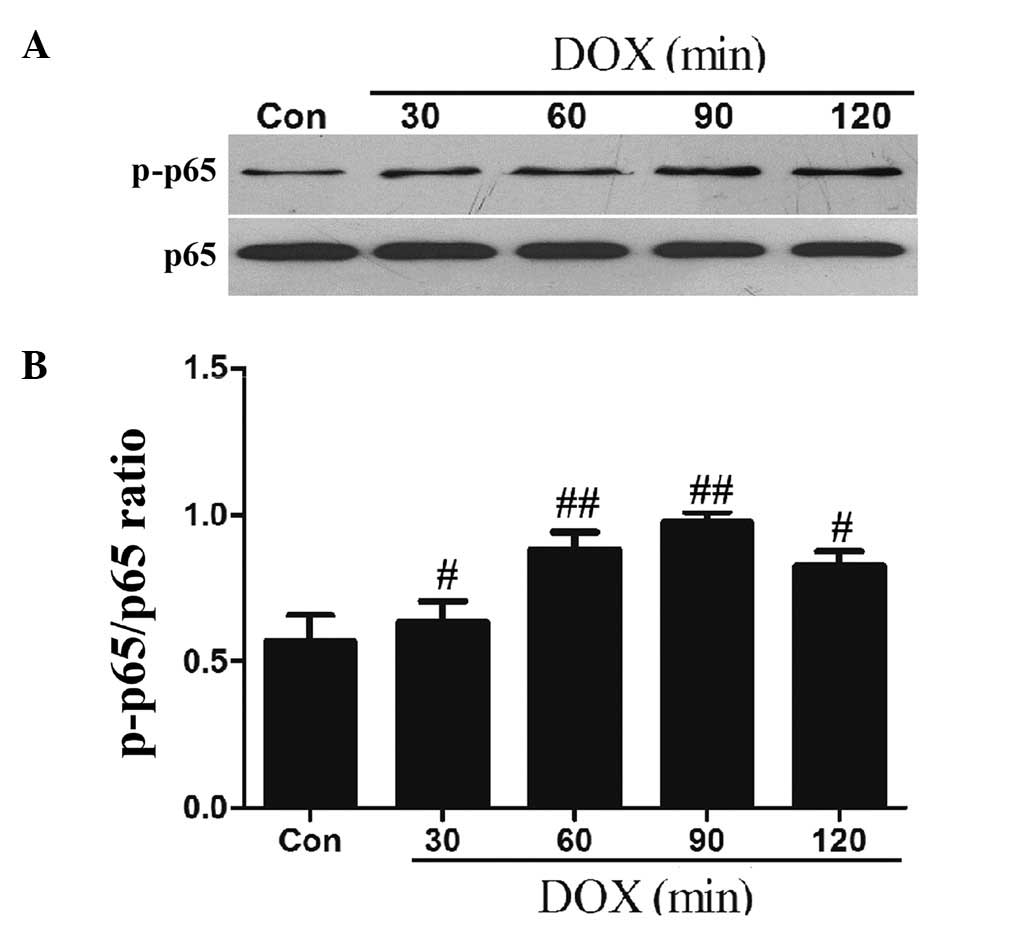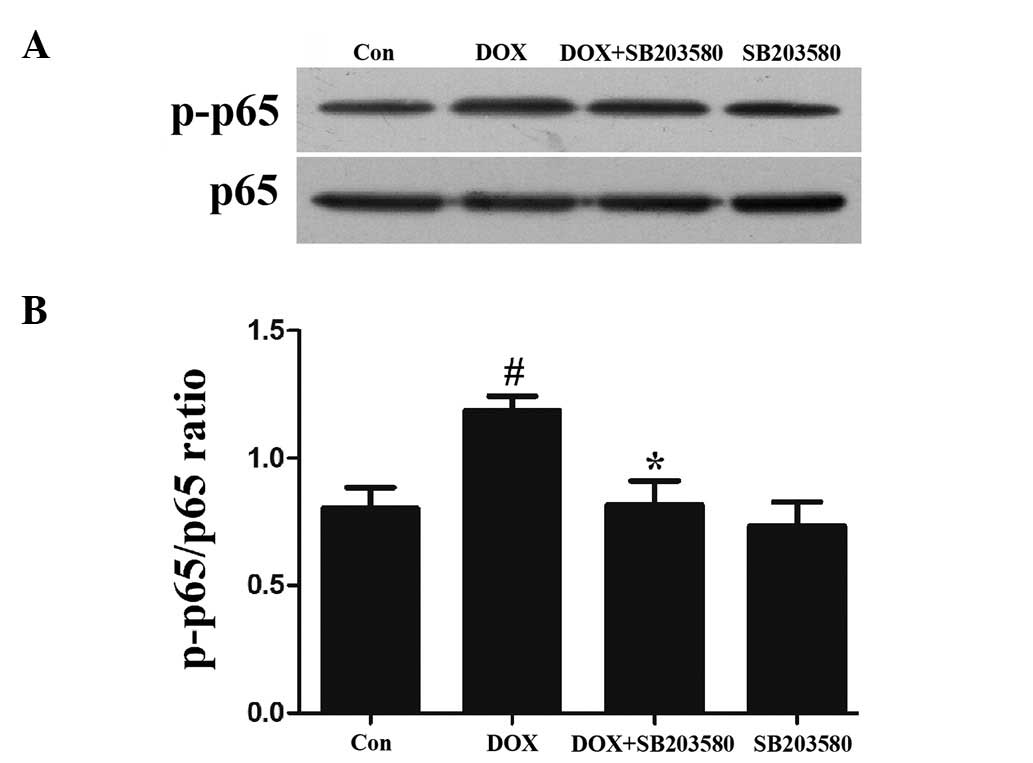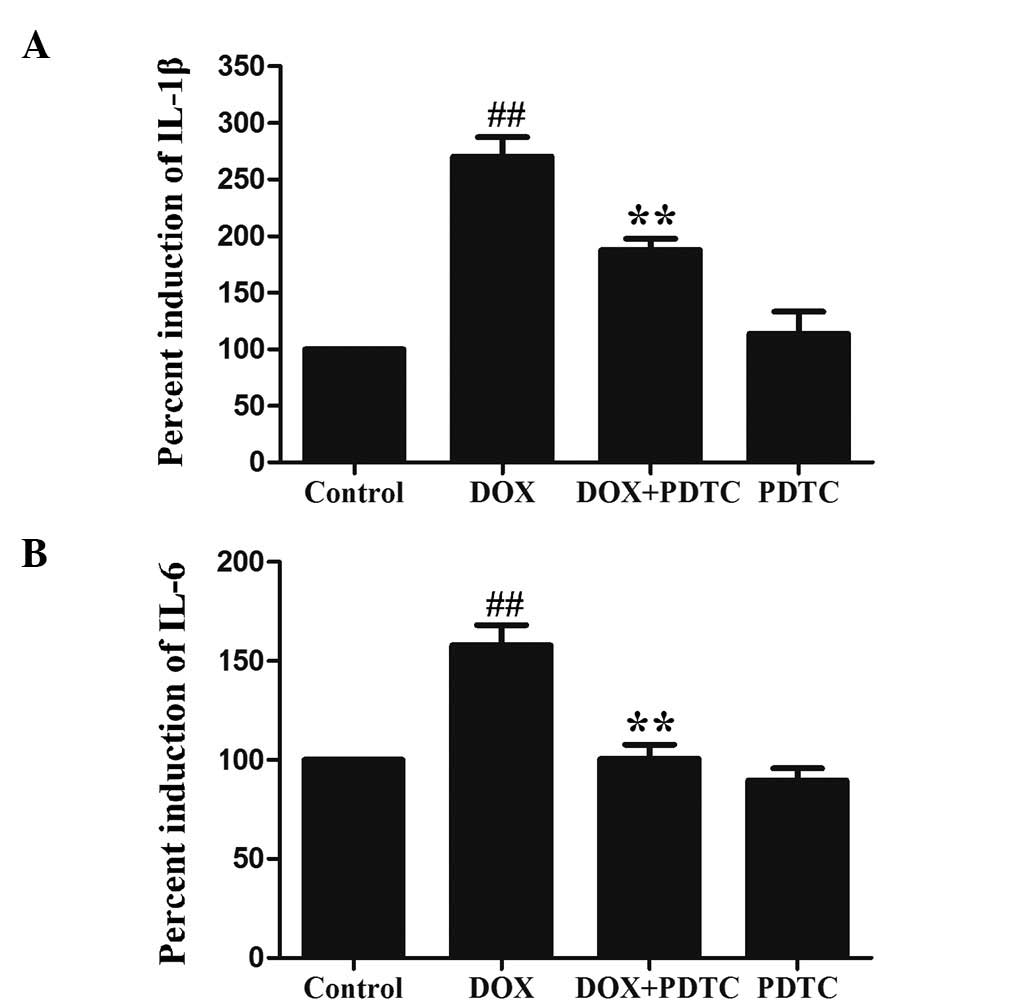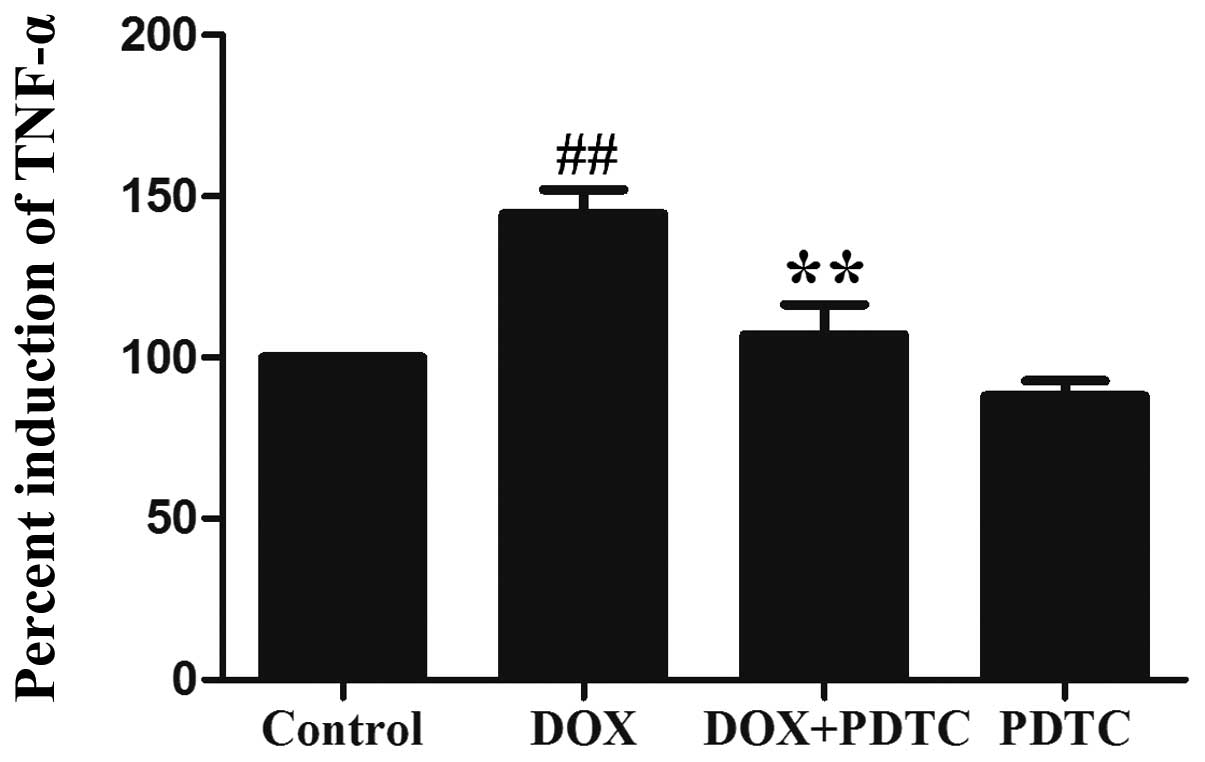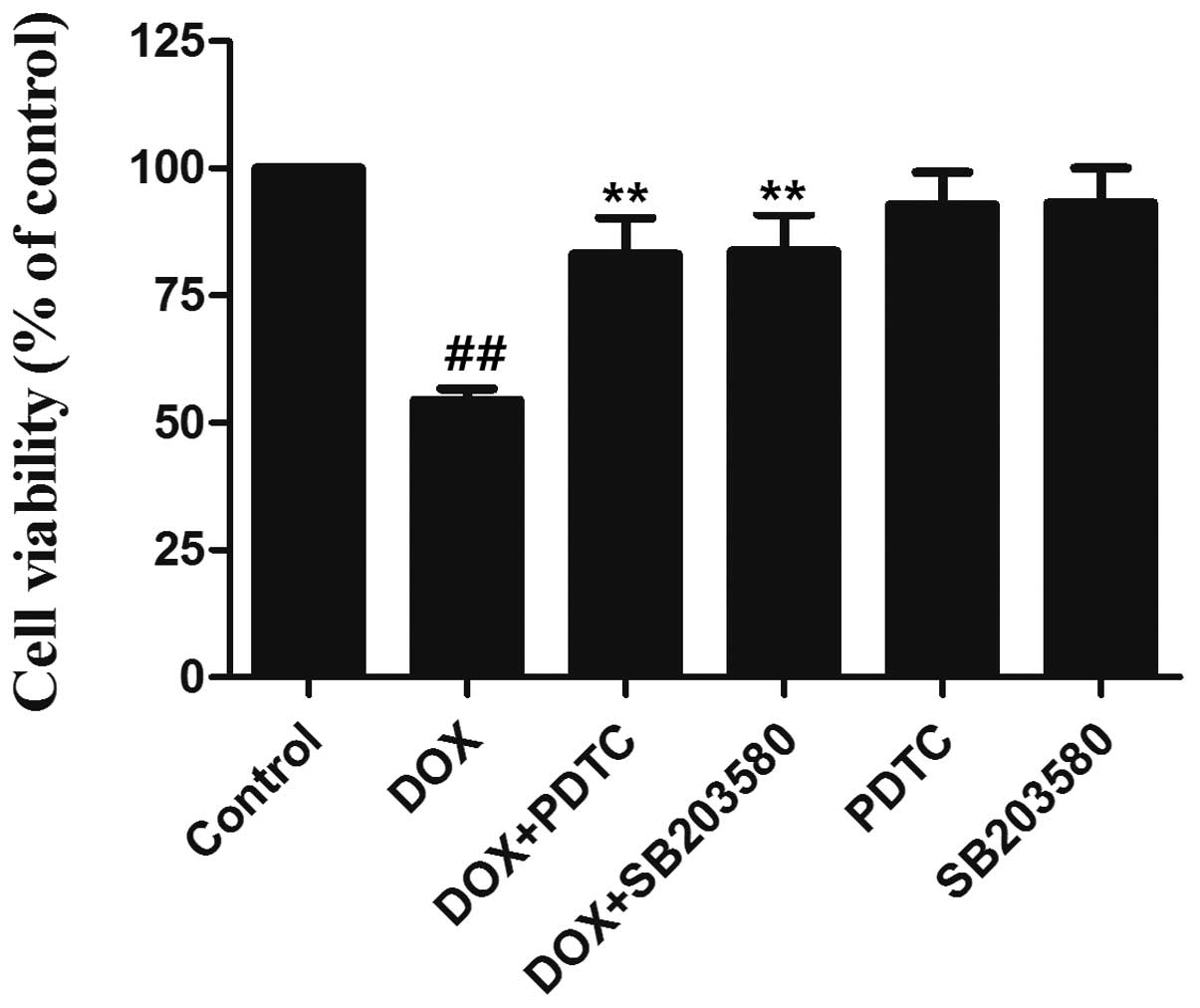Activation of the p38 MAPK/NF-κB pathway contributes to doxorubicin-induced inflammation and cytotoxicity in H9c2 cardiac cells
- Authors:
- Published online on: June 26, 2013 https://doi.org/10.3892/mmr.2013.1554
- Pages: 603-608
Abstract
Introduction
Doxorubicin (DOX) is widely used in the treatment of numerous types of human solid and hematological malignancies, including acute leukemia, lymphoma, Kaposi’s sarcoma and bone tumors, as well as stomach, breast and ovarian cancer (1). However, the clinical use of DOX is limited by severe side effects, including cardiotoxicity, which leads to heart failure (2–4). The cause of DOX-induced cardiotoxicity is multifactorial; however, cardiac inflammation and the generation of oxidative stress are known to participate in this clinical event. DOX has been shown to induce a significant increase in the levels of inflammatory markers, including interleukin (IL)-6, tumor necrosis factor-α (TNF-α) (5–8) and cyclooxygenase-2 (COX-2) (9). In a murine model of DOX-induced heart failure, an inhibitor of COX-2 was able to improve left ventricular function and mortality (10), suggesting the involvement of COX-2 in DOX-induced cardiotoxicity.
Nuclear factor-κB (NF-κB) may also be a key contributor to DOX-induced cardiotoxicity. NF-κB is a positive regulator of COX-2 expression in response to various cytokines and growth factors (11,12). The NF-κB family is composed of five proteins, Rel A (p65), Rel B, c-Rel, NF-κB1 (p50) and NF-κB2 (p52), each of which may form homo- or heterodimers. NF-κB is a dimeric transcription factor that regulates genes associated with stress responses, including inflammation, oxidative stress and apoptosis. DOX has been shown to induce NF-κB (13–15). We have recently demonstrated that the inhibition of NF-κB attenuates the cytotoxicity and levels of IL-6 and IL-8, as well as the overexpression of COX-2 in chemical hypoxia-treated HaCaT cells (16,17). These findings indicate the modulatory effect of NF-κB on inflammatory factors. However, it is unclear whether there is an association between NF-κB and inflammatory factors in DOX-induced cardiotoxicity.
The role of p38 mitogen-activated protein kinase (MAPK) in DOX-induced cardiotoxicity has been examined in several studies (18–21). p38 MAPK is a subfamily of the MAPK superfamily. This subfamily is composed of four isoforms, p38α, p38β, p38γ and p38δ (22,23), and is important in the inflammatory stress response and cell differentiation (24,25). Kang et al(18) have shown that the activation of p38 MAPK is implicated in DOX-induced apoptosis. DOX is able to activate p38α and p38β, which contribute to DOX-induced cardiomyocyte apoptosis by degradation of the transcriptional co-factor p300 (21). Our recent study has indicated that the activation of p38 MAPK is capable of enhancing the generation of reactive oxygen species (ROS) (26) and mediating chemical hypoxia-induced inflammation (data not shown), strongly indicating that p38 MAPK activation may contribute to the DOX-induced inflammatory response. The present study aimed to investigate the molecular mechanisms underlying DOX-induced inflammation in order to clarify the association between p38 MAPK and NF-κB and the roles of these two pathways in the induction of inflammatory factors, including IL-1β, IL-6 and TNF-α by DOX. The findings of the present study demonstrated that the p38 MAPK/NF-κB pathway is critical in the induction of the inflammatory response in DOX-treated H9c2 cardiac cells.
Materials and methods
Materials
DOX, SB203580 and pyrrolidine dithiocarbamate (PDTC) were purchased from Sigma-Aldrich (St. Louis, MO, USA). The Cell Counter kit-8 (CCK-8) was purchased from Dojindo Laboratories (Kumamoto, Japan). DMEM-F12 medium and fetal bovine serum (FBS) were purchased from Gibco-BRL (Carlsbad, CA, USA).
Cell culture and treatment
H9c2 embryonic rat cardiac cells (Sun Yat-sen University Experimental Animal Center, Guangzhou, China) were cultured in DMEM-F12 medium supplemented with 10% FBS at 37°C in an atmosphere of 5% CO2. To examine the effects of PDTC and SB203580 on DOX-induced injury, H9c2 cells were pretreated with PDTC (a selective inhibitor of NF-κB) for 30 min or SB203580 for 60 min prior to treatment with DOX.
Cell viability assay
After the H9c2 cells were cultured in 96-well plates and administered with the indicated treatments, 10 μl CCK-8 solution was added to each well at a 1/10 dilution, followed by a 2-h incubation. The absorbance was measured at 450 nm with a microplate reader (Multiskan MK3 Microplate reader; Thermo Fisher Scientific Inc., Waltham, MA, USA). The mean optical density (OD) of five wells in the indicated groups was used to calculate the percentage of cell viability according to the following formula: Cell viability (%) = OD treatment group/OD control group × 100. All the experiments were performed in triplicate.
Measurement of inflammatory cytokine levels using ELISA
The H9c2 cells were plated in 96-well plates. Following the administration of the indicated treatments, the relative content of each secreted inflammatory cytokine (IL-1β, IL-6 and TNF-α) in the supernatant was measured using the Cytokine ELISA kit (Boster BioTech, Wuhan, China) according to the manufacturer’s instructions. The plates were read at a wavelength of 450 nm using a microplate reader (Multiskan MK3 Microplate reader; Thermo Fisher Scientific Inc.). The relative content of inflammatory cytokines in the culture medium was corrected by cell viability. All the experiments were performed in triplicate.
Western blot assay
Following the administration of the indicated treatments, the H9c2 cells were harvested and lysed, and the homogenate was centrifuged. After the total protein in the supernatant was quantified using the BCA protein assay kit (Thermo Fisher Scientific Inc., Rockford, IL, USA), the protein (30 μg from each sample) was fractionated by 12% SDS-PAGE and then transferred onto a polyvinylidene difluoride (PVDF) membrane. The membrane was blocked with 5% free-fat milk in TBS-T for 1 h at room temperature, and then incubated with monoclona rabbit primary antibodies specific to p38 MAPK (#2371; Cell Signaling Technology Inc., Beverly, MA, USA) and phosphorylated (p)-p38 MAPK (#4631; Cell Signaling Technology Inc.) (1:4,000), NF-κB p65 (#4764; Cell Signaling Technology Inc.) and p-NF-κB p65 (#3033; Cell Signaling Technology Inc.) (1:2,000) or GAPDH with gentle agitation at 4°C overnight and subsequent incubation with horseradish peroxidase (HRP)-conjugated secondary antibodies (1:5,000 dilution) for 1.5 h at room temperature. Following three washes with TBS-T, the membranes were developed using enhanced chemiluminescence and exposed to X-ray films. To quantify protein expression, the X-ray films were scanned and analyzed with ImageJ 1.41o software (National Institutes of Health, Bethesda, MD, USA).
Statistical analysis
All data are presented as the mean ± standard error (SE). Differences between groups were analyzed by one-way analysis of variance (ANOVA) using SPSS 13.0 (SPSS, Inc., Chicago, IL, USA). P<0.05 was considered to indicate a statistically significant result.
Results
DOX induces the activation of p38 MAPK in H9c2 cells
After the H9c2 cells were treated with 5 μmol/l DOX for 15, 30 and 60 min, the expression levels of p-p38 MAPK increased in a time-dependent manner, indicating the activation of p38 MAPK by DOX treatment (Fig. 1). Alone, DOX at 5 μmol/l did not alter the expression of total p38 MAPK.
DOX upregulates the phosphorylation of NF-κB p65 in H9c2 cells
NF-κB is important in regulating genes that contribute to the onset of oxidative stress and the inflammatory response. Therefore, we observed the effect of DOX on the phosphorylation of the NF-κB p65 subunit (an essential step of NF-κB activation). The results of the western blot analysis demonstrated that after the H9c2 cells were exposed to 5 μmol/l DOX for 60 min, the expression levels of p-NF-κB p65 significantly increased, reaching peak levels at 90 min, with the higher levels being sustained until 120 min (Fig. 2).
p38 MAPK participates in the activation of NF-κB p65 by DOX in H9c2 cells
To examine the effect of the activation of p38 MAPK on the increased phosphorylation of NF-κB p65 by DOX, H9c2 cells were pretreated with 3 μmol/l SB203580, a specific inhibitor of p38 MAPK, for 60 min prior to exposure to 5 μmol/l DOX. As shown in Figs. 3A and 2B, the exposure of cells to 5 μmol/l DOX for 90 min markedly enhanced the expression levels of p-NF-κB p65, which were attenuated by treatment with SB203580, suggesting the involvement of p38 MAPK in the DOX-induced activation of NF-κB p65. SB203580 at 3 μmol/l alone did not change the basal expression level of p-NF-κB p65 in H9c2 cells (Fig. 3A and B).
Activation of NF-κB p65 contributes to DOX-induced inflammation in H9c2 cells
The levels of IL-1β and IL-6 were measured in response to DOX and PDTC (an inhibitor of NF-κB). Following the exposure of H9c2 cells to 5 μmol/l DOX for 24 h, IL-1β (Fig. 4A) and IL-6 (Fig. 4B) levels were significantly increased. Pretreatment with 100 μmol/l PDTC for 30 min prior to DOX exposure markedly ameliorated IL-1β and IL-6 levels in H9c2 cells. Additionally, the exposure of H9c2 cells to 5 μmol/l DOX significantly enhanced TNF-α (a proinflammatory cytokine) production (Fig. 5), which was reduced by pretreatment with PDTC. These results revealed that the DOX-induced inflammatory response is associated with the activation of NF-κB p65.
The p38 MAPK/NF-κB pathway is involved in DOX-induced cytotoxicity in H9c2 cells
To clarify the role of the p38 MAPK/NF-κB pathway in DOX-induced cytotoxicity, H9c2 cells were pretreated with either SB203580 (3 μmol/l) for 60 min or PDTC (100 μmol/l) for 30 min before exposure to 5 μmol/l DOX for 24 h. As shown in Fig. 6, the exposure of H9c2 cells to DOX induced significant cytotoxicity, as indicated by the decrease in cell viability. However, the decreased cell viability was markedly inhibited by pretreatment with SB203580 or PDTC, indicating that DOX-induced cytotoxicity is mediated, at least partially, by the p38 MAPK/NF-κB pathway.
Discussion
Since dose-related adverse effects, in particular cardiotoxicity, often limit the effectiveness of DOX in chemotherapy, alternative strategies using pharmaceutical agents have been investigated. Several of these agents, including dexrazoxan (27), angiotensin-converting enzyme (ACE) inhibitors (28), β-blockers (29) and vitamin E (30) have been tested in animal models and clinical studies to prevent or reduce these dose-related clinical events. However, to date, no single drug has clinically been capable of fully preventing DOX cardiotoxicity. Additional basic and clinical studies are required to validate the underlying mechanism of action of these agents. Results of the present study support the hypothesis that inflammatory responses to DOX treatment are mediated, at least partially, by the activation of the p38 MAPK/NF-κB pathway, and that certain adverse inflammatory consequences induced by DOX may be ameliorated by inhibiting the p38 MAPK/NF-κB pathway.
Recently, inflammation has been shown to play a role in DOX cardiotoxicity. DOX induces a significant increase in the levels of specific inflammatory cytokines and chemokines, including IL-1β (31), IL-6, TNF-α (5–8,31), COX-2 (9) and CCL2/MCP-1 (31). COX-2 inhibitors are capable of improving left ventricular function and mortality in murine models of DOX-induced heart failure (10). Studies with IL-1β-deficient mice have demonstrated that IL-1β signaling is critical in DOX-induced increases in IL-6 and granulocyte colony stimulating factor (GCSF) levels (31). Furthermore, DOX is able to induce the activation of NF-κB (a positive regulator of COX-2 expression) (13–15), which contributes to cardiac inflammation and necrosis (32). Since the signaling pathway that induces the expression of the 35 kDa pro-IL-1β is mediated by the activation of NF-κB and p38 MAPK (33), we hypothesize that the activation of p38 MAPK and NF-κB may modulate the inflammatory response in DOX-treated cardiomyocytes. The results of the present study confirmed our hypothesis. In agreement with previous studies (18–21), we demonstrated that the expression of p-p38 MAPK was markedly enhanced in DOX-treated H9c2 cardiac cells. In addition, the exposure of H9c2 cells led to DOX-induced activation of NF-κB, which is consistent with previous studies (13–15). Notably, we observed that the pretreatment of cells with SB203580, a specific inhibitor of p38 MAPK, attenuated the increased activation of NF-κB p65 by DOX, suggesting a modulatory effect of the p38 MAPK pathway on DOX-induced NF-κB activation. Furthermore, our results showed that DOX significantly induced inflammatory responses, as indicated by an increase in the levels of IL-1β, IL-6 and TNF-α. However, whether there is an association between the p38 MAPK/NF-κB pathway and DOX-induced inflammatory markers is unclear.
To clarify the modulatory effects of NF-κB activation on the levels of inflammatory markers, the H9c2 cells were pretreated with PDTC, a selective inhibitor of NF-κB, prior to exposure to DOX treatment. Firstly, we demonstrated that pretreatment with PDTC significantly reduced the levels of IL-1β and IL-6 induced by DOX, highlighting the modulatory role of the NF-κB pathway in the DOX-induced secretion of IL-1β and IL-6 from H9c2 cells. IL-1β is an initiator cytokine that is important in the regulation of the immune and inflammatory responses (34), and contributes to the DOX-induced increase in the levels of IL-6 and GCSF (31). Thus, elucidating the role of NF-κB in the IL-1β-mediated inflammatory response may present opportunities to inhibit the inflammatory consequences of DOX. This study also demonstrated that the activation of NF-κB is necessary for the induction of IL-1β and IL-6 by DOX in H9c2 cells. In addition, we observed that PDTC pretreatment had a notable inhibitory effect on the induction of TNF-α by DOX treatment, revealing the involvement of the NF-κB pathway in the modulation of TNF-α induction. TNF-α, a proinflammatory cytokine, may cause apoptotic cell death, cellular proliferation, differentiation, inflammation, tumorigenesis and viral replication (35). Recent studies have demonstrated that DOX increases TNF-α expression (7,31,36,37). Notably, TNF-α is capable of activating NF-κB (14). Daunorubicin, a DOX analogue, was demonstrated to strongly affect the potential ability of TNF-α to activate NF-κB, suggesting a synergy between these two agents in this response (38). Based on our results and those of previous studies (7,14,31,36–38), we suggest that a cross-talk between the NF-κB pathway and TNF-α exists, which may be important in DOX-induced inflammation. Further studies are required to confirm this hypothesis.
Additionally, we examined the role of the p38 MAPK/NF-κB pathway in DOX-induced cytotoxicity. The findings of this study showed that the pretreatment of H9c2 cells with either SB203580 or PDTC prior to exposure to DOX markedly inhibited DOX-induced cytotoxicity, leading to an increase in cell viability. The results suggest that the induction of cardiac cytotoxicity and inflammation by DOX may share common mechanisms, including the p38 MAPK/NF-κB pathway.
In conclusion, to the best of our knowledge, this is the first study to demonstrate the role of the p38 MAPK/NF-κB pathway in the DOX-induced inflammatory response in H9c2 cells. A clearer understanding of the functional significance of this pathway may constitute a potential new therapeutic option to prevent DOX-induced cardiotoxicity. However, further clinical studies are required to verify whether this hypothesis is valid in patients.
Acknowledgements
This study was supported by the Science and Technology Planning Project of Guangdong Province in China (2010B080701035 and 2009B080701014).
References
|
Danesi R, Fogli S, Gennari A, Conte P and Del Tacca M: Pharmacokinetic-pharmacodynamic relationships of the anthracycline anticancer drugs. Clin Pharmacokinet. 41:431–444. 2002. View Article : Google Scholar : PubMed/NCBI | |
|
Hrdina R, Gersl V, Klimtová I, Simůnek T, Machácková J and Adamcová M: Anthracycline-induced cardiotoxicity. Acta Medica (Hradec Kralove). 43:75–82. 2000. | |
|
Scully RE and Lipshultz SE: Anthracycline cardiotoxicity in long-term survivors of childhood cancer. Cardiovasc Toxicol. 7:122–128. 2007. View Article : Google Scholar : PubMed/NCBI | |
|
Zucchi R and Danesi R: Cardiac toxicity of antineoplastic anthracyclines. Curr Med Chem Anticancer Agents. 3:151–171. 2003. View Article : Google Scholar : PubMed/NCBI | |
|
Morsi MI, Hussein AE, Mostafa M, El-Abd E and El-Moneim NA: Evaluation of tumour necrosis factor-alpha, soluble P-selectin, gamma-glutamyl transferase, glutathione S-transferase-pi and alpha-fetoprotein in patients with hepatocellular carcinoma before and during chemotherapy. Br J Biomed Sci. 63:74–78. 2006. | |
|
Mukherjee S, Banerjee SK, Maulik M, Dinda AK, Talwar KK and Maulik SK: Protection against acute adriamycin-induced cardiotoxicity by garlic: role of endogenous antioxidants and inhibition of TNF-alpha expression. BMC Pharmacol. 3:162003. View Article : Google Scholar : PubMed/NCBI | |
|
Riad A, Bien S, Westermann D, et al: Pretreatment with statin attenuates the cardiotoxicity of Doxorubicin in mice. Cancer Res. 69:695–699. 2009. View Article : Google Scholar : PubMed/NCBI | |
|
Zordoky BN, Anwar-Mohamed A, Aboutabl ME and El-Kadi AO: Acute doxorubicin toxicity differentially alters cytochrome P450 expression and arachidonic acid metabolism in rat kidney and liver. Drug Metab Dispos. 39:1440–1450. 2011. View Article : Google Scholar : PubMed/NCBI | |
|
Huang CC, Chen PC, Huang CW and Yu J: Aristolochic Acid induces heart failure in zebrafish embryos that is mediated by inflammation. Toxicol Sci. 100:486–494. 2007. View Article : Google Scholar : PubMed/NCBI | |
|
Delgado RM 3rd, Nawar MA, Zewail AM, et al: Cyclooxygenase-2 inhibitor treatment improves left ventricular function and mortality in a murine model of doxorubicin-induced heart failure. Circulation. 109:1428–1433. 2004. View Article : Google Scholar : PubMed/NCBI | |
|
Huang CY, Fujimura M, Noshita N, Chang YY and Chan PH: SOD1 down-regulates NF-kappaB and c-Myc expression in mice after transient focal cerebral ischemia. J Cereb Blood Flow Metab. 21:163–173. 2001. View Article : Google Scholar : PubMed/NCBI | |
|
Kang YJ, Wingerd BA, Arakawa T and Smith WL: Cyclooxygenase-2 gene transcription in a macrophage model of inflammation. J Immunol. 177:8111–8122. 2006. View Article : Google Scholar : PubMed/NCBI | |
|
Lin X, Li Q, Wang YJ, et al: Morphine inhibits doxorubicin-induced reactive oxygen species generation and nuclear factor kappaB transcriptional activation in neuroblastoma SH-SY5Y cells. Biochem J. 406:215–221. 2007. View Article : Google Scholar | |
|
Riganti C, Doublier S, Costamagna C, et al: Activation of nuclear factor-kappa B pathway by simvastatin and RhoA silencing increases doxorubicin cytotoxicity in human colon cancer HT29 cells. Mol Pharmacol. 74:476–484. 2008. View Article : Google Scholar : PubMed/NCBI | |
|
Yu HG, Ai YW, Yu LL, et al: Phosphoinositide 3-kinase/Akt pathway plays an important role in chemoresistance of gastric cancer cells against etoposide and doxorubicin induced cell death. Int J Cancer. 122:433–443. 2008. View Article : Google Scholar : PubMed/NCBI | |
|
Yang C, Ling H, Zhang M, et al: Oxidative stress mediates chemical hypoxia-induced injury and inflammation by activating NF-κb-COX-2 pathway in HaCaT cells. Mol Cells. 31:531–538. 2011.PubMed/NCBI | |
|
Yang C, Yang Z, Zhang M, et al: Hydrogen sulfide protects against chemical hypoxia-induced cytotoxicity and inflammation in HaCaT cells through inhibition of ROS/NF-κB/COX-2 pathway. PLoS One. 6:e219712011.PubMed/NCBI | |
|
Kang YJ, Zhou ZX, Wang GW, Buridi A and Klein JB: Suppression by metallothionein of doxorubicin-induced cardiomyocyte apoptosis through inhibition of p38 mitogen-activated protein kinases. J Biol Chem. 275:13690–13698. 2000. View Article : Google Scholar : PubMed/NCBI | |
|
Lou H, Danelisen I and Singal PK: Involvement of mitogen-activated protein kinases in adriamycin-induced cardiomyopathy. Am J Physiol Heart Circ Physiol. 288:H1925–H1930. 2005. View Article : Google Scholar : PubMed/NCBI | |
|
Lou H, Kaur K, Sharma AK and Singal PK: Adriamycin-induced oxidative stress, activation of MAP kinases and apoptosis in isolated cardiomyocytes. Pathophysiology. 13:103–109. 2006. View Article : Google Scholar : PubMed/NCBI | |
|
Poizat C, Puri PL, Bai Y and Kedes L: Phosphorylation-dependent degradation of p300 by doxorubicin-activated p38 mitogen-activated protein kinase in cardiac cells. Mol Cell Biol. 25:2673–2687. 2005. View Article : Google Scholar | |
|
Lechner C, Zahalka MA, Giot JF, Møller NP and Ullrich A: ERK6, a mitogen-activated protein kinase involved in C2C12 myoblast differentiation. Proc Natl Acad Sci USA. 93:4355–4359. 1996. View Article : Google Scholar : PubMed/NCBI | |
|
Young PR, McLaughlin MM, Kumar S, et al: Pyridinyl imidazole inhibitors of p38 mitogen-activated protein kinase bind in the ATP site. J Biol Chem. 272:12116–12121. 1997. View Article : Google Scholar : PubMed/NCBI | |
|
Johnson GL and Lapadat R: Mitogen-activated protein kinase pathways mediated by ERK, JNK, and p38 protein kinases. Science. 298:1911–1912. 2002. View Article : Google Scholar : PubMed/NCBI | |
|
Puri PL and Sartorelli V: Regulation of muscle regulatory factors by DNA-binding, interacting proteins, and post-transcriptional modifications. J Cell Physiol. 185:155–173. 2000. View Article : Google Scholar : PubMed/NCBI | |
|
Lan AP, Xiao LC, Yang ZL, et al: Interaction between ROS and p38MAPK contributes to chemical hypoxia-induced injuries in PC12 cells. Mol Med Report. 5:250–255. 2012.PubMed/NCBI | |
|
Hensley ML, Hagerty KL, Kewalramani T, et al: American Society of Clinical Oncology 2008 clinical practice guideline update: use of chemotherapy and radiation therapy protectants. J Clin Oncol. 27:127–145. 2009. View Article : Google Scholar : PubMed/NCBI | |
|
Cardinale D, Colombo A, Sandri MT, et al: Prevention of high-dose chemotherapy-induced cardiotoxicity in high-risk patients by angiotensin-converting enzyme inhibition. Circulation. 114:2474–2481. 2006. View Article : Google Scholar : PubMed/NCBI | |
|
Kalay N, Basar E, Ozdogru I, et al: Protective effects of carvedilol against anthracycline-induced cardiomyopathy. J Am Coll Cardiol. 48:2258–2262. 2006. View Article : Google Scholar : PubMed/NCBI | |
|
Berthiaume JM, Oliveira PJ, Fariss MW and Wallace KB: Dietary vitamin E decreases doxorubicin-induced oxidative stress without preventing mitochondrial dysfunction. Cardiovasc Toxicol. 5:257–267. 2005. View Article : Google Scholar | |
|
Sauter KA, Wood LJ, Wong J, Iordanov M and Magun BE: Doxorubicin and daunorubicin induce processing and release of interleukin-1beta through activation of the NLRP3 inflammasome. Cancer Biol Ther. 11:1008–1016. 2011. View Article : Google Scholar : PubMed/NCBI | |
|
Shi Y, Moon M, Dawood S, McManus B and Liu PP: Mechanisms and management of doxorubicin cardiotoxicity. Herz. 36:296–305. 2011. View Article : Google Scholar | |
|
Bankers-Fulbright JL, Kalli KR and McKean DJ: Interleukin-1 signal transduction. Life Sci. 59:61–83. 1996. View Article : Google Scholar | |
|
Dinarello CA: IL-1: discoveries, controversies and future directions. Eur J Immunol. 40:599–606. 2010. View Article : Google Scholar : PubMed/NCBI | |
|
MacEwan DJ: TNF ligands and receptors - a matter of life and death. Br J Pharmacol. 135:855–875. 2002. View Article : Google Scholar : PubMed/NCBI | |
|
Gilliam LA, Moylan JS, Ferreira LF and Reid MB: TNF/TNFR1 signaling mediates doxorubicin-induced diaphragm weakness. Am J Physiol Lung Cell Mol Physiol. 300:L225–L231. 2011. View Article : Google Scholar : PubMed/NCBI | |
|
Riad A, Bien S, Gratz M, et al: Toll-like receptor-4 deficiency attenuates doxorubicin-induced cardiomyopathy in mice. Eur J Heart Fail. 10:233–243. 2008. View Article : Google Scholar : PubMed/NCBI | |
|
Boland MP, Foster SJ and O’Neill LA: Daunorubicin activates NFkappaB and induces kappaB-dependent gene expression in HL-60 promyelocytic and Jurkat T lymphoma cells. J Biol Chem. 272:12952–12960. 1997. View Article : Google Scholar : PubMed/NCBI |



